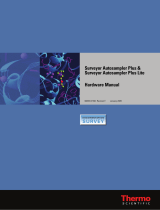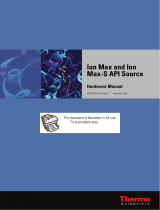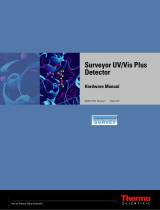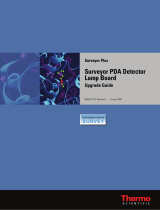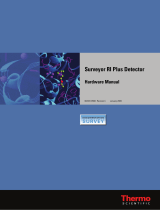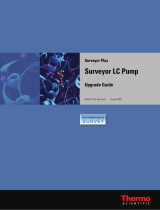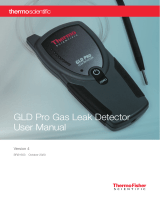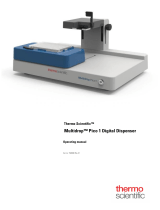La pagina si sta caricando...

© 2010 Thermo Fisher Scientific Inc. All rights reserved.
Xcalibur, and Accela are registered trademarks and MSQ is a trademark of Thermo Fisher Scientific in the
United States.
The following are registered trademarks in the United States and other countries: Hewlett-Packard and
JetDirect are registered trademarks of Hewlett-Packard Company. Agilent is a registered trademark of Agilent
Technologies, Inc. Intel and Pentium are registered trademarks of Intel Corporation. KEL-F is a registered
trademark of 3M Corporation. Kimwipe is a registered trademark of Kimberly-Clark Corporation. Microsoft
and Windows are registered trademarks of Microsoft Corporation. Swagelok is a registered trademark of
Crawford Fitting Company. Delrin, Kalrez, Teflon, Tefzel, Vespel, and Viton are registered trademarks of E.I.
du Pont de Nemours & Co. Tygon is a registered trademark of Norton Industrial Plastics. Dell is a trademark
of Dell inc. PEEK is a trademark of Victrex plc. Convectron is a registered trademark of Granville-Phillips
Company.
All other trademarks are the property of Thermo Fisher Scientific Inc. and its subsidiaries.
Thermo Fisher Scientific Inc. provides this document to its customers with a product purchase to use in the
product operation. This document is copyright protected and any reproduction of the whole or any part of this
document is strictly prohibited, except with the written authorization of Thermo Fisher Scientific Inc.
The contents of this document are subject to change without notice. All technical information in this
document is for reference purposes only. System configurations and specifications in this document supersede
all previous information received by the purchaser.
Thermo Fisher Scientific Inc. makes no representations that this document is complete, accurate or error-
free and assumes no responsibility and will not be liable for any errors, omissions, damage or loss that might
result from any use of this document, even if the information in the document is followed properly.
This document is not part of any sales contract between Thermo Fisher Scientific Inc. and a purchaser. This
document shall in no way govern or modify any Terms and Conditions of Sale, which Terms and Conditions of
Sale shall govern all conflicting information between the two documents.
Release history: Revision A August 2006, Revision B November 2007, Revision C March 2010
Software version: Xcalibur 2.0 or later, MSQ 2.0
For Research Use Only. Not for use in diagnostic procedures.

Regulatory Compliance
Thermo Fisher Scientific performs complete testing and evaluation of its products to ensure full compliance with
applicable domestic and international regulations. When the system is delivered to you, it meets all pertinent
electromagnetic compatibility (EMC) and safety standards as described below.
Changes that you make to your system may void compliance with one or more of these EMC and safety standards.
Changes to your system include replacing a part or adding components, options, or peripherals not specifically
authorized and qualified by Thermo Fisher Scientific. To ensure continued compliance with EMC and safety standards,
replacement parts and additional components, options, and peripherals must be ordered from Thermo Fisher Scientific
or one of its authorized representatives.
EMC Directive 89/336/EEC as amended by 92/31/EEC and 93/68/EEC
EMC compliance has been evaluated by UNDERWRITERS LABORATORY, INC (UL).
Low-Voltage Safety Compliance
This device complies with the EU directive 73/23/EEC (equivalent to IEC 1010-1, 1990 plus Amendment 1, 1991
and Amendment 2, 1995) by meeting the following standard: EN 61010-1: 2001 with Corrigendum No. 1 and 2.
FCC Compliance Statement
EN 55011 (1998) EN 61000-4-3 (2002)
EN 61326-1 (1998) EN 61000-4-4 (2001)
EN 61000-3-2 1995 EN 61000-4-5 (2001)
EN 61000-3-3 1995 EN 61000-4-6 (2001)
EN 61000-4-2 (2001) EN 61000-4-11 (2001)
CFR 47 Part 15 Subpart B: 2004
Code of Federal Regulations, Part 15, Subpart B, Radio Frequency Devices Unintentional Radiators
Class A
THIS DEVICE COMPLIES WITH PART 15 OF THE FCC RULES. OPERATION IS SUBJECT TO
THE FOLLOWING TWO CONDITIONS: (1) THIS DEVICE MAY NOT CAUSE HARMFUL
INTERFERENCE, AND (2) THIS DEVICE MUST ACCEPT ANY INTERFERENCE RECEIVED,
INCLUDING INTERFERENCE THAT MAY CAUSE UNDESIRED OPERATION.

Notice on Lifting and Handling of
Thermo Fisher Scientific Instruments
For your safety, and in compliance with international regulations, the physical handling of this Thermo Fisher Scientific
instrument requires a team effort to lift and/or move the instrument. This instrument is too heavy and/or bulky for one
person alone to handle safely.
Notice on the Proper Use of
Thermo Fisher Scientific Instruments
In compliance with international regulations: Use of this instrument in a manner not specified by Thermo Fisher
Scientific could impair any protection provided by the instrument.
Notice on the Susceptibility
to Electromagnetic Transmissions
Your instrument is designed to work in a controlled electromagnetic environment. Do not use radio frequency
transmitters, such as mobile phones, in close proximity to the instrument.
For manufacturing location, see the label on the instrument.
CAUTION Read and understand the various precautionary notes, signs, and symbols contained inside
this manual pertaining to the safe use and operation of this product before using the device.

WEEE Compliance
This product is required to comply with the European Union’s Waste Electrical & Electronic
Equipment (WEEE) Directive 2002/96/EC. It is marked with the following symbol:
Thermo Fisher Scientific has contracted with one or more recycling or disposal companies in each
European Union (EU) Member State, and these companies should dispose of or recycle this product.
See www.thermo.com/WEEERoHS for further information on Thermo Fisher Scientific’s compliance
with these Directives and the recyclers in your country.
WEEE Konformität
Dieses Produkt muss die EU Waste Electrical & Electronic Equipment (WEEE) Richtlinie 2002/96/EC
erfüllen. Das Produkt ist durch folgendes Symbol gekennzeichnet:
Thermo Fisher Scientific hat Vereinbarungen mit Verwertungs-/Entsorgungsfirmen in allen EU-
Mitgliedsstaaten getroffen, damit dieses Produkt durch diese Firmen wiederverwertet oder entsorgt
werden kann. Mehr Information über die Einhaltung dieser Anweisungen durch Thermo Fisher
Scientific, über die Verwerter, und weitere Hinweise, die nützlich sind, um die Produkte zu
identifizieren, die unter diese RoHS Anweisung fallen, finden sie unter www.thermo.com/
WEEERoHS.

Conformité DEEE
Ce produit doit être conforme à la directive européenne (2002/96/EC) des Déchets d'Equipements
Electriques et Electroniques (DEEE). Il est marqué par le symbole suivant:
Thermo Fisher Scientific s'est associé avec une ou plusieurs compagnies de recyclage dans chaque état
membre de l’union européenne et ce produit devrait être collecté ou recyclé par celles-ci. Davantage
d'informations sur la conformité de Thermo Fisher Scientific à ces directives, les recycleurs dans votre
pays et les informations sur les produits Thermo Fisher Scientific qui peuvent aider la détection des
substances sujettes à la directive RoHS sont disponibles sur www.thermo.com/WEEERoHS.

CAUTION Symbol CAUTION VORSICHT ATTENTION PRECAUCION AVVERTENZA
Electric Shock: This instrument uses
high voltages that can cause personal
injury. Before servicing, shut down the
instrument and disconnect the instrument
from line power. Keep the top cover on
while operating the instrument. Do not
remove protective covers from PCBs.
Elektroschock: In diesem Gerät werden
Hochspannungen verwendet, die
Verletzungen verursachen können. Vor
Wartungsarbeiten muß das Gerät
abgeschaltet und vom Netz getrennt
werden. Betreiben Sie Wartungsarbeiten
nicht mit abgenommenem Deckel. Nehmen
Sie die Schutzabdeckung von Leiterplatten
nicht ab.
Choc électrique: L’instrument utilise des
tensions capables d’infliger des blessures
corprelles. L’instrument doit être arrêté et
débranché de la source de courant avant
tout intervention. Ne pas utiliser
l’instrument sans son couvercle. Ne pas
elensver les étuis protecteurs des cartes de
circuits imprimés.
Descarga eléctrica: Este instrumento
utiliza altas tensiones, capaces de
producir lesiones personales. Antes de
dar servicio de mantenimiento al
instrumento, éste debera apagarse y
desconectarse de la línea de alimentacion
eléctrica. No opere el instrumento sin sus
cubiertas exteriores quitadas. No remueva
las cubiertas protectoras de las tarjetas
de circuito impreso.
Shock da folgorazione. L’apparecchio è
alimentato da corrente ad alta tensione
che puo provocare lesioni fisiche. Prima di
effettuare qualsiasi intervento di
manutenzione occorre spegnere ed isolare
l’apparecchio dalla linea elettrica. Non
attivare lo strumento senza lo schermo
superiore. Non togliere i coperchi a
protezione dalle schede di circuito
stampato (PCB).
Chemical: This instrument might contain
hazardous chemicals. Wear gloves when
handling toxic, carcinogenic, mutagenic,
or corrosive or irritant chemicals. Use
approved containers and proper
procedures to dispose waste oil.
Chemikalien: Dieses Gerät kann
gefährliche Chemikalien enthalten. Tragen
Sie Schutzhandschuhe beim Umgang mit
toxischen, karzinogenen, mutagenen oder
ätzenden/reizenden Chemikalien.
Entsorgen Sie verbrauchtes Öl
entsprechend den Vorschriften in den
vorgeschriebenen Behältern.
Chimique: Des produits chemiques
dangereux peuven se trouver dans
l’instrument. Proted dos gants pour
manipuler tous produits chemiques
toxiques, cancérigènes, mutagènes, ou
corrosifs/irritants. Utiliser des récipients
et des procédures homologuées pour se
débarrasser des déchets d’huile.
Química: El instrumento puede contener
productos quimicos peligrosos. Utilice
guantes al manejar productos quimicos
tóxicos, carcinogenos, mutagenos o
corrosivos/irritantes. Utilice recipientes y
procedimientos aprobados para
deshacerse del aceite usado.
Prodotti chimici. Possibile presenza di
sostanze chimiche pericolose
nell’apparecchio. Indossare dei guanti per
maneggiare prodotti chimici tossici,
cancerogeni, mutageni, o
corrosivi/irritanti. Utilizzare contenitori
aprovo e seguire la procedura indicata per
lo smaltimento dei residui di olio.
Heat: Before servicing the instrument,
allow any heated components to cool.
Hitze: Warten Sie erhitzte Komponenten
erst nachdem diese sich abgekühlt haben.
Haute Temperature: Permettre aux
composants chauffés de refroidir avant
tout intervention.
Altas temperaturas: Permita que lop
componentes se enfríen, ante de efectuar
servicio de mantenimiento.
Calore. Attendere che i componenti
riscaldati si raffreddino prima di
effetturare l’intervento di manutenzione.
Fire: Use care when operating the system
in the presence of flammable gases.
Feuer: Beachten Sie die einschlägigen
VorsichtsmaBnahmen, wenn Sie das
System in Gegenwart von entzündbaren
Gasen betreiben.
Incendie: Agir avec précaution lors de
l’utilisation du système en présence de
gaz inflammables.
Fuego: Tenga cuidado al operar el
sistema en presencia de gases
inflamables.
Incendio. Adottare le dovute precauzioni
quando si usa il sistema in presenza di gas
infiammabili.
Eye Hazard: Eye damage could occur
from splattered chemicals or flying
particles. Wear safety glasses when
handling chemicals or servicing the
instrument.
Verletzungsgefahr der Augen:
Verspritzte Chemikalien oder kleine
Partikel können Augenverletzungen
verursachen. Tragen Sie beim Umgang mit
Chemikalien oder bei der Wartung des
Gerätes eine Schutzbrille.
Danger pour les yeux: Dex projections
chimiques, liquides, ou solides peuvent
être dangereuses pour les yeux. Porter des
lunettes de protection lors de toute
manipulationde produit chimique ou pour
toute intervention sur l’instrument.
Peligro par los ojos: Las salicaduras de
productos químicos o particulas que
salten bruscamente pueden causar
lesiones en los ojos. Utilice anteojos
protectores al mnipular productos
químicos o al darle servicio de
mantenimiento al instrumento.
Pericolo per la vista. Gli schizzi di
prodotti chimici o delle particelle presenti
nell’aria potrebbero causare danni alla
vista. Indossare occhiali protettivi quando
si maneggiano prodotti chimici o si
effettuano interventi di manutenzione
sull’apparecchio.
General Hazard: A hazard is present that
is not included in the above categories.
Also, this symbol appears on the
instrument to refer the user to instructions
in this manual.
Allgemeine Gefahr: Es besteht eine
weitere Gefahr, die nicht in den
vorstehenden Kategorien beschrieben ist.
Dieses Symbol wird im Handbuch
auBerdem dazu verwendet, um den
Benutzer auf Anweisungen hinzuweisen.
Danger général: Indique la présence
d;un risque n’appartenant pas aux
catégories citées plus haut. Ce symbole
figure également sur l’instrument pour
renvoyer l’utilisateur aux instructions du
présent manuel.
Peligro general: Significa que existe un
peligro no incluido en las categorias
anteriores. Este simbolo también se utiliza
en el instrumento par referir al usuario a
las instrucciones contenidas en este
manual.
Pericolo generico. Pericolo non
compreso tra le precedenti categorie.
Questo simbolo è utilizzato inoltre
sull’apparecchio per segnalare all’utente
di consultare le istruzioni descritte nel
presente manuale.
When the safety of a procedure is
questionable, contact your local Technical
Support organization for Thermo Fisher
Scientific San Jose Products.
Wenn Sie sich über die Sicherheit eines
Verfahrens im unklaren sind, setzen Sie
sich, bevor Sie fortfahren, mit Ihrer
lokalen technischen
Unterstützungsorganisation für Thermo
Fisher Scientific San Jose Produkte in
Verbindung.
Si la sûreté d’un procédure est incertaine,
avant de continuer, contacter le plus
proche Service Clientèle pour les produits
de Thermo Fisher Scientific San Jose.
Cuando la certidumbre acerca de un
procedimiento sea dudosa, antes de
proseguir, pongase en contacto con la
Oficina de Asistencia Tecnica local para
los productos de Thermo Fisher Scientific
San Jose.
Quando e in dubbio la misura di sicurezza
per una procedura, prima di continuare, si
prega di mettersi in contatto con il
Servizio di Assistenza Tecnica locale per i
prodotti di Thermo Fisher Scientific San
Jose.

CAUTION Symbol CAUTION
Electric Shock: This instrument uses
high voltages that can cause personal
injury. Before servicing, shut down the
instrument and disconnect the instrument
from line power. Keep the top cover on
while operating the instrument. Do not
remove protective covers from PCBs.
Chemical: This instrument might contain
hazardous chemicals. Wear gloves when
handling toxic, carcinogenic, mutagenic,
or corrosive or irritant chemicals. Use
approved containers and proper
procedures to dispose waste oil.
Heat: Before servicing the instrument,
allow any heated components to cool.
Fire: Use care when operating the system
in the presence of flammable gases.
Eye Hazard: Eye damage could occur
from splattered chemicals or flying
particles. Wear safety glasses when
handling chemicals or servicing the
instrument.
General Hazard: A hazard is present that
is not included in the above categories.
Also, this symbol appears on the
instrument to refer the user to instructions
in this manual.
When the safety of a procedure is
questionable, contact your local Technical
Support organization for Thermo Fisher
Scientific San Jose Products.

Thermo Scientific MSQ Plus Mass Detector Getting Connected Guide ix
C
Preface . . . . . . . . . . . . . . . . . . . . . . . . . . . . . . . . . . . . . . . . . . . . . . . . . . . . . . . . . . . . . . xi
Related Documentation . . . . . . . . . . . . . . . . . . . . . . . . . . . . . . . . . . . . . . . . . . .xi
Safety and Special Notices . . . . . . . . . . . . . . . . . . . . . . . . . . . . . . . . . . . . . . . . .xi
Safety Precautions. . . . . . . . . . . . . . . . . . . . . . . . . . . . . . . . . . . . . . . . . . . . . . . xii
Contacting Us . . . . . . . . . . . . . . . . . . . . . . . . . . . . . . . . . . . . . . . . . . . . . . . . .xiii
Chapter 1 Introduction . . . . . . . . . . . . . . . . . . . . . . . . . . . . . . . . . . . . . . . . . . . . . . . . . . . . . . . . . . .1
Connecting the Forepump . . . . . . . . . . . . . . . . . . . . . . . . . . . . . . . . . . . . . . . . . 2
Using the Oil Mist Filter Kit and the Drain Oil Return Kit . . . . . . . . . . . . . . . . 5
Connecting the Oil Mist Filter to the Forepump. . . . . . . . . . . . . . . . . . . . . . . 6
Connecting the Drain Adapter to the Oil Mist Filter . . . . . . . . . . . . . . . . . . . 7
Connecting the Hose Adapter to the Forepump . . . . . . . . . . . . . . . . . . . . . . . 7
Connecting the Drain of the Oil Mist Filter to the Gas Ballast Port . . . . . . . . 8
Connecting the Exhaust Lines . . . . . . . . . . . . . . . . . . . . . . . . . . . . . . . . . . . . . . . 9
Connecting to the Nitrogen Source. . . . . . . . . . . . . . . . . . . . . . . . . . . . . . . . . . 13
Connecting the Nitrogen Supply to the Mass Detector . . . . . . . . . . . . . . . . . 13
Checking for Air Leaks . . . . . . . . . . . . . . . . . . . . . . . . . . . . . . . . . . . . . . . . . 15
Connecting to Line Power. . . . . . . . . . . . . . . . . . . . . . . . . . . . . . . . . . . . . . . . . 17
Connecting to the Data System Computer . . . . . . . . . . . . . . . . . . . . . . . . . . . . 19
Chapter 2 Connecting the Accela LC System . . . . . . . . . . . . . . . . . . . . . . . . . . . . . . . . . . . . . . .21
Checking the Ethernet Card Settings. . . . . . . . . . . . . . . . . . . . . . . . . . . . . . . . . 21
Connecting the System Interconnect Cable. . . . . . . . . . . . . . . . . . . . . . . . . . . . 22
The 7-Connector Interconnect Cable . . . . . . . . . . . . . . . . . . . . . . . . . . . . . . 22
Connecting the LC Outlet to the Mass Detector. . . . . . . . . . . . . . . . . . . . . . . . 24
Chapter 3 Installing the API Probe . . . . . . . . . . . . . . . . . . . . . . . . . . . . . . . . . . . . . . . . . . . . . . . .25
Switching from ESI to APCI . . . . . . . . . . . . . . . . . . . . . . . . . . . . . . . . . . . . . . . 26
Switching from APCI to ESI . . . . . . . . . . . . . . . . . . . . . . . . . . . . . . . . . . . . . . . 28
Chapter 4 Connecting the Cone Wash Pump . . . . . . . . . . . . . . . . . . . . . . . . . . . . . . . . . . . . . . .31
Connecting the Cone Wash Pump to the MSQ Plus Mass Detector . . . . . . . . . 31
Adjusting the Cone Wash Nozzle . . . . . . . . . . . . . . . . . . . . . . . . . . . . . . . . . . . 33
Controlling the Cone Wash Pump Through Timed Events . . . . . . . . . . . . . . . 34
Adjusting the Flow Rate of the Cone Wash Solvent . . . . . . . . . . . . . . . . . . . . . 37
Contents

Contents
xMSQ Plus Mass Detector Getting Connected Guide Thermo Scientific
Chapter 5 Control of External Devices. . . . . . . . . . . . . . . . . . . . . . . . . . . . . . . . . . . . . . . . . . . . .39
MSQ Plus Mass Detector User I/O Terminals . . . . . . . . . . . . . . . . . . . . . . . . . 39
External Devices Controlled by Xcalibur Data System. . . . . . . . . . . . . . . . . . . . 40
Wiring a System Controlled by Xcalibur for Contact Closure . . . . . . . . . . . . 40
Selecting the Appropriate Start Instrument . . . . . . . . . . . . . . . . . . . . . . . . . . 41
External Devices Not Controlled by the Xcalibur Data System . . . . . . . . . . . . . 42
Wiring Your System for Contact Closure . . . . . . . . . . . . . . . . . . . . . . . . . . . 42
Running a Sequence from the Xcalibur Data System. . . . . . . . . . . . . . . . . . . 43
Index . . . . . . . . . . . . . . . . . . . . . . . . . . . . . . . . . . . . . . . . . . . . . . . . . . . . . . . . . . . . . . . .47

Thermo Scientific MSQ Plus Mass Detector Getting Connected Guide xi
P
Preface
This MSQ Plus Mass Detector Getting Connected Guide Guide explains how to set up your
MSQ™ Plus Mass Detector and how to connect an external device to the mass detector.
Related Documentation
In addition to this guide, Thermo Fisher Scientific provides the following documents in PDF
format for the MSQ Plus Mass Detector:
• MSQ Plus Mass Detector Hardware Manual
• MSQ Plus Mass Detector Getting Started Guide
• MSQ Plus Mass Detector Preinstallation Guide
• MSQ Plus Mass Detector Calmix Kit Preparation Guide
The software also provides Help.
YTo suggest changes to documentation or to Help
Complete a brief survey about this document by clicking the link below.
Thank you in advance for your help.
Safety and Special Notices
Make sure you follow the precautionary statements presented in this guide. The safety and
other special notices appear in boxes.
Safety and special notices include the following:
CAUTION Highlights hazards to humans, property, or the environment. Each CAUTION
notice is accompanied by an appropriate CAUTION symbol.

Preface
Safety Precautions
xii MSQ Plus Mass Detector Getting Connected Guide Thermo Scientific
Safety Precautions
Observe the following safety precautions when you operate or perform service on the MSQ
Plus Mass Detector:
Do not perform any servicing other than that contained in the MSQ Plus Mass Detector
Hardware Manual. To avoid personal injury or damage to the instrument, do not perform
any servicing other than that contained in the MSQ Plus Mass Detector Hardware Manual or
related manuals unless you are qualified to do so.
Shut down the mass detector and disconnect it from line power before you service it.
High voltages capable of causing personal injury are used in the instrument. Some
maintenance procedures require that the mass detector be shut down and disconnected from
line power before service is performed. Do not operate the mass detector with the top or side
covers off. Do not remove protective covers from PCBs.
Do not interfere with the safety interlock. Interfering with the safety interlock will expose
you to potentially lethal electrical hazards.
Respect heated zones. Treat heated zones with respect. The ion transfer capillary and the
APCI vaporizer might be very hot and might cause severe burns if touched. Allow heated
components to cool before you service them.
Place the mass detector in Standby (or Off) before you open the atmospheric pressure
ionization (API) source. The presence of atmospheric oxygen in the API source when the
mass detector is On could be unsafe. The mass detector automatically goes into Standby when
you open the API source; however, to take this added precaution for safety reasons.
Take care when handling the corona pin. The corona pin is sharp and can cause personal
injury. Take care when removing or installing the corona pin.
Make sure you have sufficient nitrogen for your API source. Before you begin normal
operation each day, make sure that you have sufficient nitrogen for your API source. The
presence of atmospheric oxygen in the API source when the mass detector is on could be
unsafe. The mass detector automatically goes into Standby when you run out of nitrogen;
however, take this added precaution for safety reasons.
IMPORTANT Highlights information necessary to prevent damage to software, loss of
data, or invalid test results; or might contain information that is critical for optimal
performance of the system.
Note Highlights information of general interest.
Tip Highlights helpful information that can make a task easier.

Preface
Contacting Us
Thermo Scientific MSQ Plus Mass Detector Getting Connected Guide xiii
Contain waste streams. Because the API source can accommodate high solvent flow rates,
you must make provisions to collect the waste solvent.
Provide adequate fume exhaust systems for the API source solvent waste container and
the forepump. Your laboratory must be equipped with at least two fume exhaust systems: one
to vent the waste container connected to the exhaust port (API solvent drain) on the back of
the mass detector and the other to vent the forepump exhaust. As described in the MSQ Plus
Mass Detector Getting Connected Guide, route the (blue) forepump exhaust hose to a dedicated
fume exhaust system. Because the exhaust hose acts as a trap for exhaust fumes that would
otherwise recondense in the forepump oil, the hose should travel at floor level for a minimum
of two meters (78.5 in.) before it reaches the external exhaust system. Route tubing from the
waste container connected to the exhaust port on the back of the mass detector to a second
dedicated fume exhaust system. Consult local regulations for the proper method of exhausting
the fumes from your system.
Do not vent the PVC drain tube (or any vent tubing connected to the waste container) to the
same fume exhaust system that is connected to the forepump. The forepump exhaust contains
pump oil, which can seriously contaminate the analyzer optics of the mass spectrometer.
Contacting Us
There are several ways to contact Thermo Fisher Scientific for the information you need.
YTo contact Technical Support
Find software updates and utilities to download at mssupport.thermo.com.
YTo contact Customer Service for ordering information
YTo copy manuals from the Internet
Go to mssupport.thermo.com and click Customer Manuals in the left margin of the
window.
Phone 800-532-4752
Fax 561-688-8736
E-mail us.techsupport.analyze@thermofisher.com
Knowledge base www.thermokb.com
Phone 800-532-4752
Fax 561-688-8731
E-mail us.customer-support.analyze@thermofisher.com
Web site www.thermo.com/ms

Preface
Contacting Us
xiv MSQ Plus Mass Detector Getting Connected Guide Thermo Scientific
YTo suggest changes to documentation or to Help
• Fill out a reader survey online at
http://www.surveymonkey.com/s.aspx?sm=R7gKOvhLXn3NTkpK2BefHQ_3d_3d.
• Send an e-mail message to the Technical Publications Editor at
techpubs-lcms@thermofisher.com.

Thermo Scientific MSQ Plus Mass Detector Getting Connected Guide 1
1
Introduction
This chapter explains how to connect your Thermo Scientific MSQ Plus Mass Detector,
shown in Figure 1, to your nitrogen source, line power, and data system computer. It also
describes how to connect the Edwards forepump to your mass detector and how to connect
the exhaust lines from the mass detector and the forepump to your laboratory venting system.
Contents
•Connecting the Forepump
•Using the Oil Mist Filter Kit and the Drain Oil Return Kit
•Connecting the Exhaust Lines
•Connecting to the Nitrogen Source
•Connecting to Line Power
•Connecting to the Data System Computer

1 Introduction
Connecting the Forepump
2MSQ Plus Mass Detector Getting Connected Guide Thermo Scientific
Figure 1. MSQ Plus Mass Detector and Accela™ LC
Connecting the Forepump
Your MSQ Plus Mass Detector is shipped with an Edwards forepump. Before connecting the
forepump, ensure that it is filled to the correct level with the factory-supplied oil. For more
detailed information on these procedures, refer to the manual that comes with the Edwards
forepump or to the MSQ Plus Mass Detector Hardware Manual.
YTo connect the Edwards forepump to the mass detector
1. Use a KF25 O-ring (part number 6071201) and a KF25 clamp (part number 6071203)
to connect the T-piece to the inlet port of the Edwards forepump.
2. To connect the vacuum hose that exits the rear of the MSQ Plus Mass Detector through
the source manifold to one side of the T-piece (see connection 1 in Figure 2), do the
following:
a. Fit a hose clamp over the free end of the vacuum hose and insert a KF25 adapter into
the end of the hose. Tighten the clamp to secure the adapter.
Note At the time of installation, a Thermo Fisher Scientific service engineer will connect
the forepump to the MSQ Plus Mass Detector.

1 Introduction
Connecting the Forepump
Thermo Scientific MSQ Plus Mass Detector Getting Connected Guide 3
b. Use a KF25 O-ring and a KF25 clamp to connect the KF25 adapter on the end of the
vacuum hose one side of the T-piece. Tighten the clamp to secure the connection.
3. To connect the vacuum hose that exits the rear of the MSQ Plus Mass Detector through
the backing manifold to the other side of the T-piece (see connection 2 in Figure 2):
a. Fit a hose clamp over the free end of the vacuum hose and insert a KF25 adapter into
the end of the hose. Tighten the clamp to secure the adapter.
b. Use a KF25 O-ring and a KF25 clamp to connect the KF25 adapter on the end of the
vacuum hose to the other side of the T-piece. Then tighten the clamp to secure the
connection.
4. Connect the power cord of the Edwards forepump to the PUMP OUT receptacle on the
rear panel of the MSQ Plus Mass Detector. See connection 3 in Figure 2.
Note The vacuum hoses are hard-wired into the MSQ Plus Mass Detector. Do not
attempt to remove them.

1 Introduction
Connecting the Forepump
4MSQ Plus Mass Detector Getting Connected Guide Thermo Scientific
Figure 2. Connecting the forepump to the MSQ Plus Mass Detector
For information on connecting the forepump exhaust line, refer to “Connecting the Exhaust
Lines” on page 9.
PUMP OUT
MAINS IN
MAINS ON/OFF
RESET
USER I/O START IN +
START IN -
USB
READY OUT +
READY OUT -
GAS IN
6 BARS MAX
SOURCE
BACKING
EXHAUST
30
EDWARDS
I
0
1
2
3
Power switch
Power supply to forepump
MSQ Plus Mass Detector
Edwards forepump
T-Piece
Exhaust port
Connection 1: Source to forepump
Connection 2: Backing to forepump
Connection 3: Forepump power plug to
PUMP OUT receptacle

1 Introduction
Using the Oil Mist Filter Kit and the Drain Oil Return Kit
Thermo Scientific MSQ Plus Mass Detector Getting Connected Guide 5
Using the Oil Mist Filter Kit and the Drain Oil Return Kit
The oil mist filter captures oil mist from the exhaust port of the forepump that would
otherwise be ejected into the atmosphere. The oil drain return kit allows you to periodically
return oil trapped in the oil mist filter back to the forepump.
The oil mist filter kit contains both the EMF20 oil mist filter kit and the drain oil return kit.
Instructions for installing the oil mist filter and the drain oil return are included in this kit, as
well as in this section. The EMF20 oil mist filter kit contains the parts listed in Tabl e 1. The
drain oil return kit contains the parts listed in Table 2.
To connect the oil mist filter and the drain oil return to your forepump, follow these
procedures:
1. Connecting the Oil Mist Filter to the Forepump
2. Connecting the Drain Adapter to the Oil Mist Filter
IMPORTANT You must place the MSQ Plus Mass Detector on a benchtop within 2.5 m
of a connection to your laboratory venting system.
Table 1. Parts included in the oil mist filter kit
Part Quantity
Oil mist filter 1
Adapter 1
O-ring seal 1
Centering ring and O-ring 1
Clamp 1
Table 2. Parts included in the drain oil return kit
Part Quantity
Drain adapter 1
Gas ballast adapter 1
O-ring 1
Bonded seals 2
Banjo bolt 1
Flexible return tubing 1
Flow restrictor 1
Hose clips 2

1 Introduction
Using the Oil Mist Filter Kit and the Drain Oil Return Kit
6MSQ Plus Mass Detector Getting Connected Guide Thermo Scientific
3. Connecting the Hose Adapter to the Forepump
4. Connecting the Drain of the Oil Mist Filter to the Gas Ballast Port
Connecting the Oil Mist Filter to the Forepump
Follow these steps to connect the oil mist filter to the forepump.
YTo connect the oil mist filter to the exhaust port of the Edwards forepump
1. Turn the power switch on the Edwards forepump to the Off position. If its power cable is
attached to Pump Out receptacle on the rear panel of the MSQ Plus Mass Detector,
detach it. See Figure 2 on page 4.
2. Use a 1.25 in. wrench to remove the brass pipe fitting (see Figure 2) that extends from the
exhaust port of the Edwards forepump.
3. Clean the area around the exhaust port of the forepump.
4. Fit the O-ring seal to the adapter.
5. Screw the adapter into the exhaust port of the forepump and hand-tighten. See Figure 3.
Do not overtighten the adapter or you will damage the O-ring seal.
Figure 3. Connecting the oil mist filter to the Edwards forepump
30
EDWARDS
Flow
oil
Clamp
Adaptor
O-ring
Exhaust port
Oil mist filter
Bonded seal
Centering-ring
Gas ballast
knob
Drain plug
/

